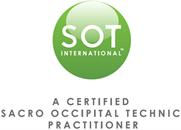Vector Point Cranial Therapy
Developped by Dr. David Denton (http://www.davidgdentondc.com/)
A low force and non-invasive method of cranial adjustment affecting the whole body
The meningeal are fibrous sheet that covers your brain and spinal cord. Their attachments begin inside your skull and then work their way down your spinal canal, finally anchoring at the lowest bone in your spine, the sacrum. The meningeal has many purposes, one of which is to allow for the free flowing of cerebral spinal fluid. This process, called the Cranial Sacral Respiratory Mechanism (CSRM), is maintained in part by the subtle movements of the cranial bones. When the cranial bones are misaligned, meningeal tension is created, causing the structural biomechanics and the jaw joints to react. These, in turn, cause an entire pattern of compensation and adaptation to take place within the body including in soft tissues like organs and extremities as an example.
How Does It Work?
By applying sustained gentle pressure to the cranium on specific points your practitioner is able to gradually un-torque meningeal pull pattern created by a whole body adaptation to react and protect itself. Because this process also removes cranial bone misalignment, the net effect is not only the correction of the cranial bones themselves, but also the correction of all other secondary distortions of the whole body and other related conditions.
The Benefits
By clearing blockages and correcting spinal and cranial subluxations Vector Point Cranial Therapy will help boost your general well being, reduce stress, improve the quality of your sleep, increase your energy, enhance the functioning of all the body’s organs and specifically relieve nerve problems which have been causing arm and leg pains, headaches, and dizziness.
Vector Point Cranial Therapy is however, not a specific treatment for a medical condition but a general method for improving the health and resilience of the human body.
Vector Point Cranial Therapy is also used in painful rehabilitation by D. Stéphane Provencher. He is currently researching a pain FREE way to rehabilitation using specific vector point.
Vector Point RESEARCH:
Viscerosomatic Reflex and Cranial Vector Points in a 38-Year Case of Mid-Thoracic Pain – A Case Report
Abstract:
Case Presentation:
A 51 year-old male presented with a 38-year history of mid-thoracic pain. During these years he sought chiropractic care, physical therapy and rehabilitation which gave him no more than 70% relief at the time, and the pain came back full force three days post treatment.
Method:
Occipital fiber analysis revealed occipital fiber 7 line 3 for T6 major. A line 3 correction was performed by adjusting C2 which decreased the pedicle pain threshold of T6. A cross pedicle adjustment was then performed on T6. CMRT according to Dr. MB De Jarnette was also administered. Vector point for T6 was performed using the Denton cervical indicator and OF 4 on the right.
Results:
The patient experienced a 30% reduction of pain after the occipital fiber line 3 adjustments. Another 20% reduction was achieved after CMRT using post- and pre-ganglionic reflexes. During the Denton vector point the pain threshold went from 50% to 5% in two minutes of holding these points. The patient stood up and walked in the office for 15 minutes, and the pain disappeared. At the next appointment the patient stated that the pain level remained at zero until the next morning when it came back at 15% and the following day at 35%. Another identical treatment was performed, and his pain level remained at zero for three days.
Conclusion:
This case report, involving occipital fiber assessment, treatment and cranial vector point, suggests an identifiable cranial-viscerosomatic relationship which correlates with De Jarnette Chiropractic Craniopathy and Dr. Denton vector points. Further studies with a larger sample of subjects are needed to determine if the findings in this case series can offer diagnosis analysis system options for patients with viscerosomatic presentation.



